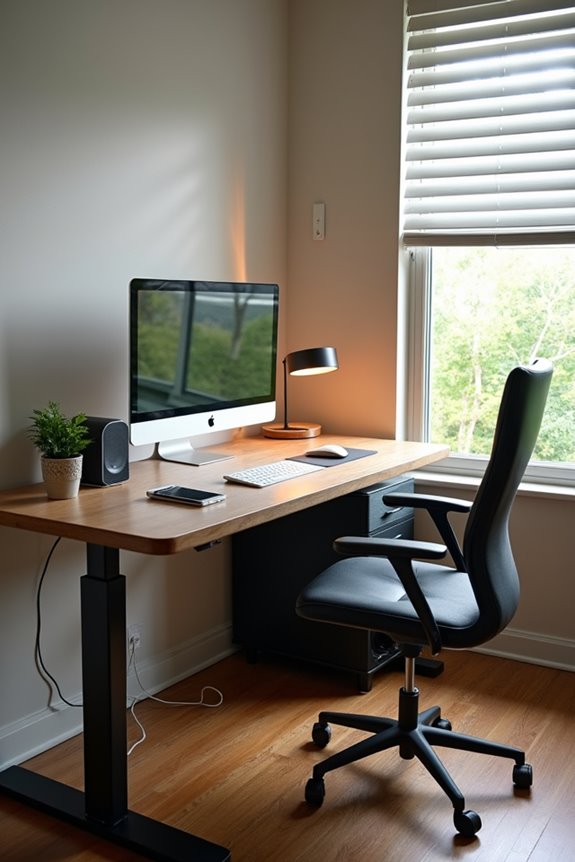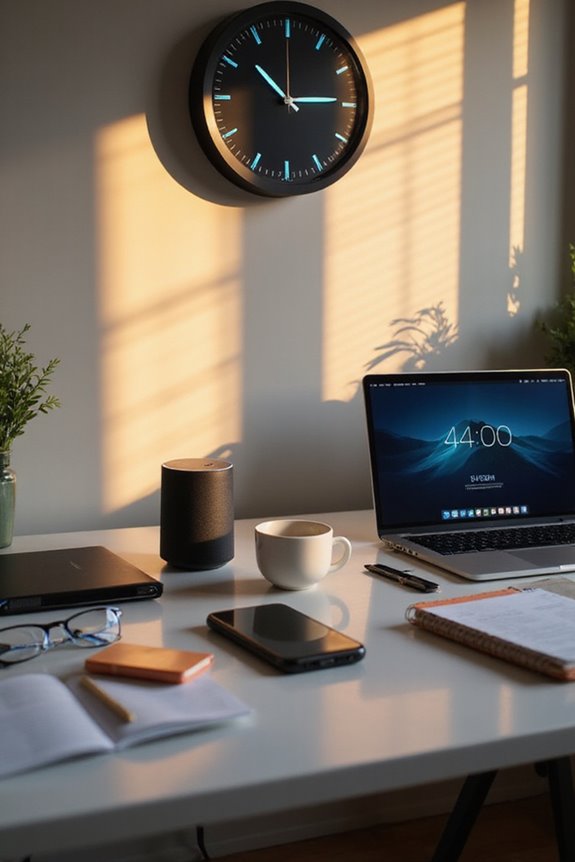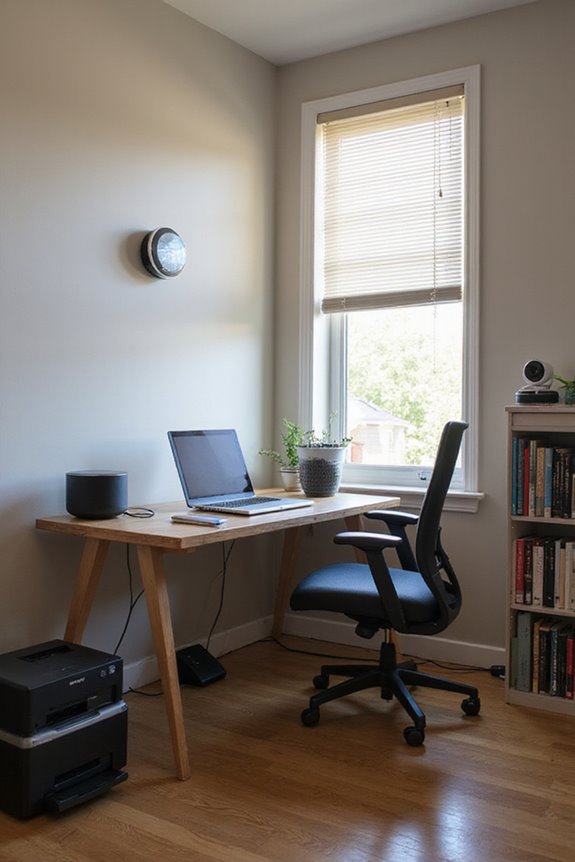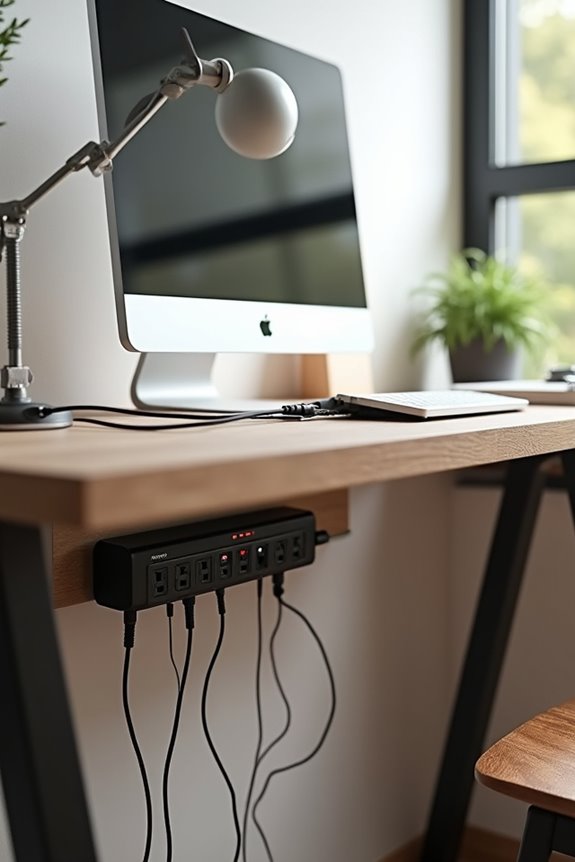To start building a smart home office, I recommend evaluating your workspace needs first. Focus on ergonomics, choosing supportive furniture and effective lighting. Next, select the right equipment, such as ergonomic keyboards and high-quality monitors. Integrate smart technology, like voice assistants and smart lighting, to enhance functionality. Finally, prioritize connectivity and security to protect your data. With these steps, you’ll create an efficient environment, and there are more tips ahead for optimizing your setup.
Key Takeaways
- Assess your workspace needs by evaluating ergonomic setup, desk height, and chair support for comfort and productivity.
- Choose reliable smart technology like smart lighting and voice assistants to streamline tasks and enhance control over your environment.
- Invest in high-speed internet and business-grade networking solutions to ensure seamless connectivity for all devices.
- Prioritize network security with firewalls and regular updates to protect sensitive information and maintain data integrity.
- Organize your workspace efficiently by minimizing clutter and incorporating inspiring elements like artwork and plants for a conducive work atmosphere.
Assessing Your Workspace Needs
How can I guarantee my workspace is optimized for productivity and comfort? The first step is conducting a thorough workspace evaluation. Begin by evaluating the ergonomic setup of your desk and chair, ensuring they provide adequate support. Next, check the lighting conditions; proper illumination can greatly affect your focus. Monitor positioning is vital too; it should be directly in front and slightly below eye level.
Organize your work surface, minimizing clutter by keeping frequently used items within easy reach. Additionally, consider soliciting employee feedback regarding their workspace needs and potential distractions. This insight will help identify areas for improvement. Finally, establish reminders for regular breaks to promote mental and physical well-being, maintaining overall productivity in your home office. Incorporating adjustable lumbar support in your chair can significantly enhance your comfort during long working hours.
Choosing the Right Equipment
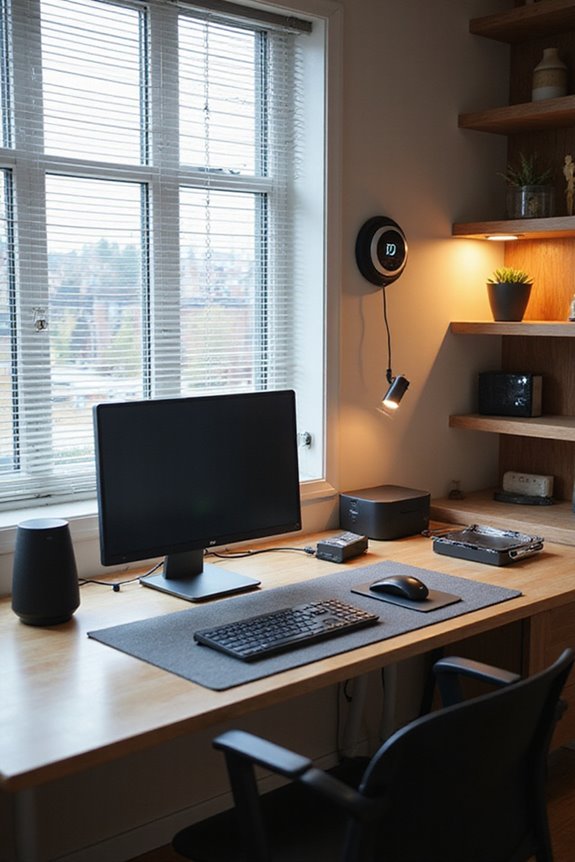
Selecting the right equipment for your smart home office is essential to creating a functional and efficient workspace. Start with essential peripherals like ergonomic keyboards and mice that enhance comfort and reduce fatigue. For display options, consider high-quality monitors with adjustable height settings, allowing for better visual clarity and multitasking. Additionally, ergonomic designs can significantly improve your typing experience and overall comfort during extended use. Storage solutions are crucial, so invest in external hard drives for secure data backup. When it comes to lighting choices, adjustable LED bulbs can create the perfect ambiance for any task. Additionally, USB power strips help manage devices efficiently. By carefully selecting these elements, you’ll set a solid foundation for a productive and organized home office environment.
Integrating Smart Technology

Integrating smart technology into your home office can greatly enhance productivity and comfort. First, consider smart device integration, such as installing smart lighting systems that adjust brightness based on your work schedule. Voice-controlled assistants like Amazon Echo can streamline routines by managing connected devices through simple commands.
Additionally, smart thermostats can optimize your office temperature automatically, ensuring a comfortable environment. Smart plugs and power strips allow you to control power supply and set schedules for devices, reducing energy waste. It’s crucial to choose smart plugs with safety certifications to ensure optimal performance and user safety.
Lastly, embracing IoT automation enables your devices to communicate intelligently, creating a cohesive smart home office experience. By thoughtfully integrating these technologies, you can create an efficient workspace tailored to your needs.
Enhancing Productivity With Tools
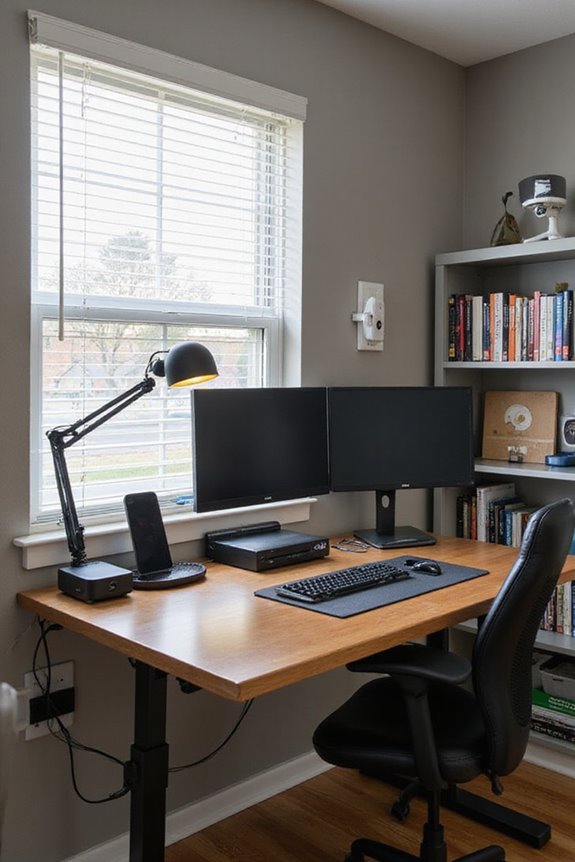
As remote work becomes more prevalent, the right tools can greatly boost our productivity. I’ve found that integrating effective productivity tools is essential for optimizing our remote collaboration. For instance, virtual meeting platforms help maintain clear communication, but it’s crucial to balance them with focused work time to prevent interruptions.
Additionally, AI-driven tools can analyze our work patterns, providing insights that enhance efficiency. Employing time management tools can also minimize distractions, allowing us to make the most of our working hours. With 77% of remote workers reporting increased productivity, investing in these tools can lead to significant performance improvements, ultimately transforming our home office into a more productive environment. Furthermore, incorporating ergonomic accessories can significantly improve comfort and support during long hours of work.
Designing an Aesthetic Office Space
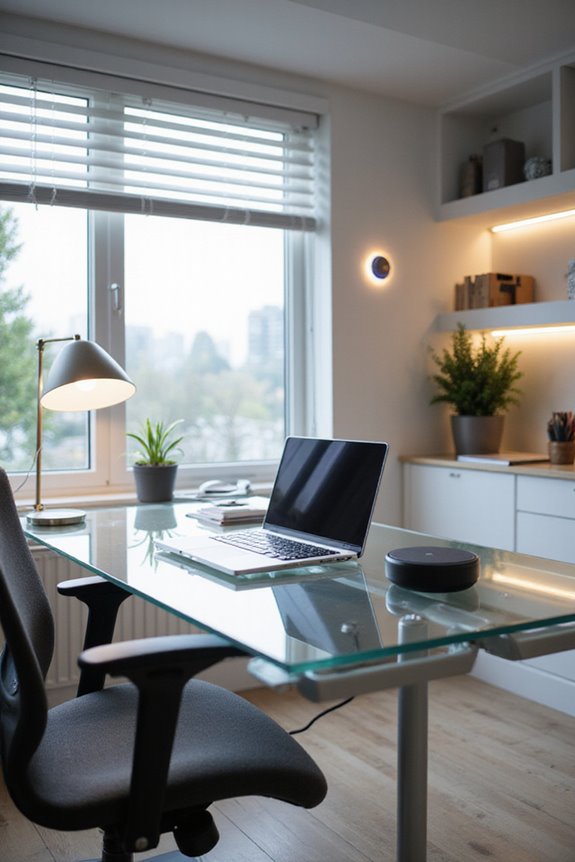
Designing an aesthetic office space is essential for creating an environment that not only reflects personal style but also enhances productivity. One of the first steps is to take into account color psychology; calming colors like soft blues or greens can promote focus and tranquility. Next, choose art selection that inspires you. Artwork not only decorates the space but can also stimulate creativity and boost morale.
Incorporating natural elements, such as plants, adds warmth and fosters well-being. Ergonomic furniture is vital for comfort while maintaining a stylish look. Finally, keeping your workspace organized minimizes clutter, ensuring a professional appearance that supports your work efficiency. By thoughtfully blending these elements, you can create an aesthetically pleasing office that supports your productivity. Additionally, investing in stylish desk organizers can further enhance your workspace’s efficiency and reduce clutter.
Implementing Maintenance and Security Measures
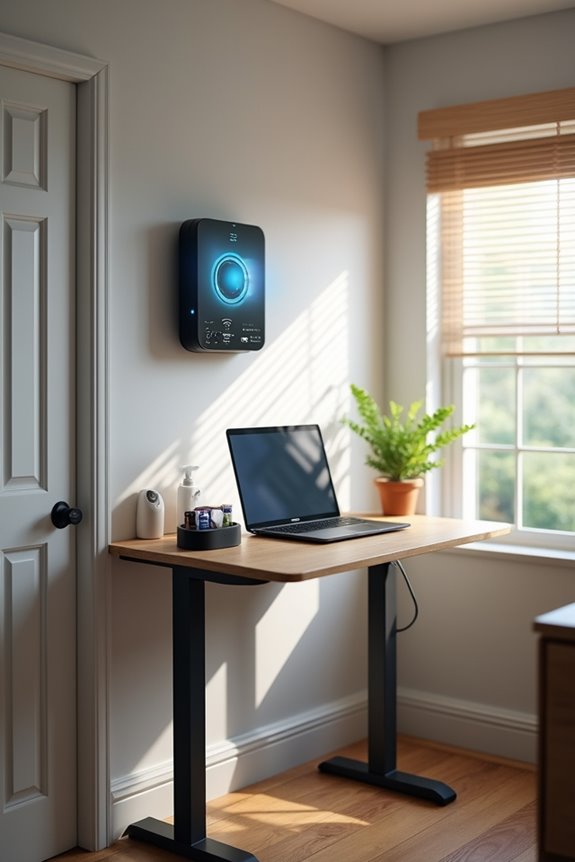
When setting up a smart home office, maintaining efficiency and security is essential to guarantee a seamless working environment. First, I focus on smart device maintenance. Regular updates for all devices help prevent security vulnerabilities. I also perform physical checks on devices like smart thermostats and security cameras to verify they’re functioning properly.
Next, I implement network security protocols. I secure my home network to prevent unauthorized access and use encryption on devices to protect sensitive data. Regular password updates and proper firewall configurations further enhance security. Additionally, I periodically review network settings to maintain stability and prevent breaches. By prioritizing these measures, I create a more efficient and secure workspace that supports my productivity.
Creating a Clutter-Free Environment
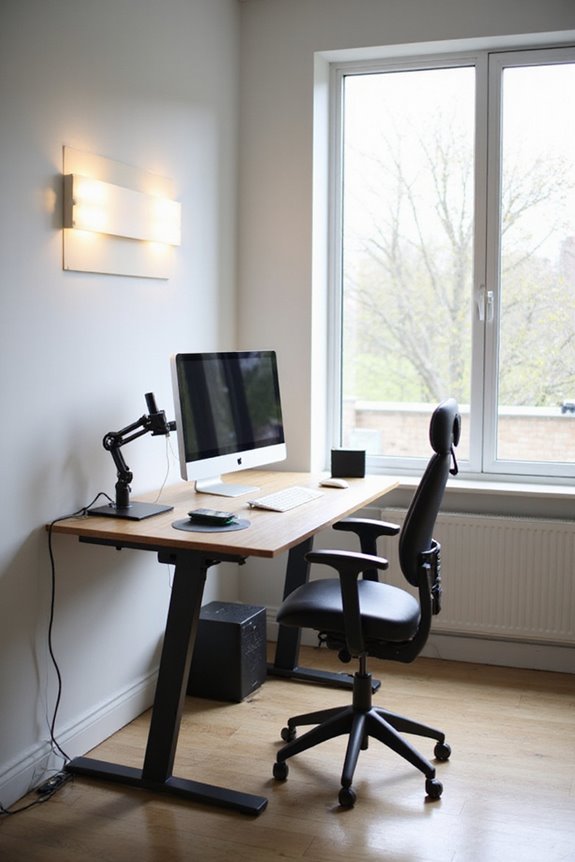
Creating a clutter-free environment is essential for enhancing productivity in a smart home office. To start, I recommend evaluating your space for clutter hotspots like mail, cables, and documents. By measuring your area, you can identify potential storage solutions. Prioritize items you use daily and consider adopting multi-functional furniture that offers built-in charging and modular options.
Next, shift non-essential paperwork to digital formats, establishing a digital-only zone to streamline your workflow. Implement a “one in, one out” rule to maintain minimalism. Finally, schedule regular decluttering sessions, creating clear zones for different categories. This systematic approach will help uphold digital organization and guarantee your workspace remains efficient and focused, ultimately benefiting your productivity.
Prioritizing Ergonomics and Comfort

Prioritizing ergonomics and comfort in your smart home office is vital for maintaining productivity and well-being throughout your workday. Start with an ergonomic chair that supports your spine, featuring adjustable height and lumbar support. Consider a height-adjustable desk to alternate between sitting and standing, enhancing circulation.
Incorporate ergonomic accessories like keyboards and mice to minimize strain on your wrists and hands. Proper monitor placement at eye level is essential for avoiding neck strain. Don’t forget about comfort zones; using footrests and acoustic materials can greatly improve your workspace. Finally, guarantee adequate task lighting to reduce eye strain, creating an environment conducive to focus and productivity.
Optimizing Connectivity and Communication

To guarantee that your smart home office runs smoothly, it’s essential to focus on optimizing connectivity and communication. First, consider business-grade solutions like those from Netgear for reliable, high-speed network infrastructure. Upgrading your routers and switches can greatly enhance network performance, ensuring that all devices communicate efficiently.
Next, implementing effective communication strategies is key. Unified communication platforms, such as Microsoft Teams, allow for seamless integration of video conferencing and messaging, improving team collaboration. Additionally, integrating voice assistants can provide hands-free control of your smart devices, streamlining tasks. Finally, prioritize network security with robust measures like firewalls to protect your sensitive data, ensuring that your smart home office is both efficient and secure.
Frequently Asked Questions
What Budget Should I Set for Building a Smart Home Office?
When pondering your budget for a smart home office, I’m reminded of the unpredictable costs. It’s vital to embrace budget flexibility while considering essential cost considerations—device choices, installation fees, and future upgrades can impact everything.
How Can I Measure My Workspace for Furniture Fitting?
When measuring my workspace dimensions, I make certain to account for furniture arrangement by leaving at least 36 inches of clearance. This guarantees comfort and efficiency, allowing me to work without feeling cramped or restricted.
Which Smart Devices Offer the Best Compatibility?
When considering smart devices, I find that options like smart thermostats with voice assistant integration really enhance compatibility. Devices like Nest Learning Thermostat seamlessly work with Alexa and Google, creating a cohesive smart environment.
What Are the Energy-Saving Benefits of Smart Devices?
It’s funny how I stumbled upon energy efficiency through smart automation. I’ve noticed my bills drop considerably, thanks to smart appliances and lighting. They really do make a difference in reducing energy consumption and costs!
How Often Should I Update My Smart Home Office Technology?
I recommend checking for updates quarterly to maximize technology lifespan and guarantee peak performance. Staying on top of update frequency keeps your devices secure and efficient, making your smart home office more effective overall.

